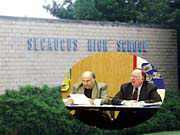The $14 million expansion of the Secaucus Middle School/High School complex was delayed again last week when bids came in higher than expected. The Board of Education voted to reject the bids and seek new bids on Oct. 16.
This will guarantee an additional delay to a project originally slated to begin last June. Late approvals from the state delayed the project and forced officials to seek bids in August.
Bids were about 10 percent above expectations, according to school officials. Bidding for all aspects of the project ran from about $13 million to $20 million.
The project was broken out into five basic bidding areas. Four bids were received for general contracting services, ranging from a low bid of about $9.5 million to a high of $12 million. Seven companies bid to supply the steel needed for construction of the new auditorium and other aspects, from $525,000 to a high bid of $695,000. Three companies bid on the drainage and sprinkler contract from $587,000 to about $1.1 million. Seven companies bid on heating and ventilation work running from $1.2 million to $5 million. Four companies bid on electrical work, ranging from about $1.1 million to $1.7 million.
Voters had approved a $14 million expansion in September 2002 to cover a range of repairs and changes to the schools, including the conversion of former workshop spaces into classrooms, and other educational-based projects. This also included the construction of a 1,000-seat auditorium. Part of this bond had already gone to complete roofing work at the high school middle school as well as to complete work on the two elementary schools.
The plan for the high school/middle school expansion also includes turning two large workshops into eight regular-sized classrooms and two special study rooms. Part of the reconstruction of the workshops includes building an access corridor from a loading area to the cafeteria kitchen, allowing people to transport supplies and meals without using student hallways.
The project also set aside $400,000 to upgrade kitchen equipment from electric to gas and allocated more than $1 million to reconfigure rooms on the second level of the high school for science labs.
The project also includes constructing classrooms for music and other outside work.
The auditorium is perhaps the biggest change in the whole expansion project, since it requires new construction in an area currently occupied by a parking lot traffic circle.
Oil, blackout…
Oil contamination found at the proposed construction site for the auditorium in April – which did not substantially delaying the project – did increased the overall cost of the project when board members were forced to seek an environmental cleanup company to take care of the issue.
In August, bidding was delayed when one or more vendors asked for more time to put together their bid packages, apparently thrown off by the August power outage.
Board Administrator Ed Walkiewicz said costs of construction apparently have gone up.
"We seem to be the victim of market forces," he said, adding that the board would seek new bids. "If these are two high as well, then the law permits us to negotiate for the lowest price we can get."
Construction will start at some point after that, although this would be subject to weather conditions.
Walkiewicz
said the architects have reviewed the bid specifications, but have made no substantive changes."They may have tweaked the bids a little, but there were no material changes," Walkiewicz said.
…and mold
Fears of a mold that had apparently spread through several classrooms at the high school/middle school complex caused school officials to close down the building for one day last week.
Several teachers had expressed fear that the mold might be a health risk, some even took the precaution of wearing masks.
Schools Superintendent Constantino Scerbo said the mold was found on Wednesday Sept. 10. After discussions with school officials, custodians and others, he decided to close the school on Friday Sept. 12, to get a full evaluation from school and health professionals.
Bill Keebe, of the Sparta-based Environmental Health Investigations, led the investigation of the mold and also tested air quality in the buildings.
"We took samples throughout the infected area, and we determined that it was a non-toxic mold," he said. "The air samples showed less air spores than normal outdoor background levels."
Walkiewicz
said the mold affected "a handful of classrooms" and the problem was isolated quickly."We removed whatever tiles were discolored, and cleaned the surfaces where the mold appeared," he said.
The mold was cleaned using a detergent-like substance.
Scerbo said staff members worked Friday and throughout the weekend cleaning the mold. He said the Board of Education would determine how the day would be made up by the students.
Further investigations are being made to determine the cause of the mold, Scerbo said.
Keebe said moisture was the likely source. This year has seen significantly more rainfall than in recent years.
"This mold will attach itself to building materials, but it is not the type to be toxic," he said.
